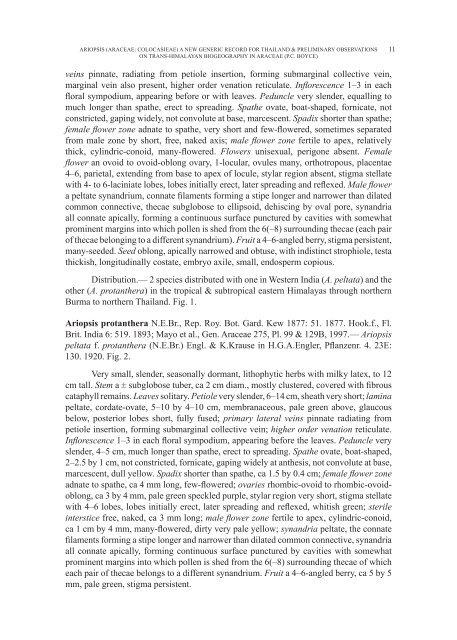You also want an ePaper? Increase the reach of your titles
YUMPU automatically turns print PDFs into web optimized ePapers that Google loves.
ARIOpSIS (ARACEAE: COLOCASIEAE) A NEW GENERIC RECORD FOR <strong>THAI</strong>LAND & pRELIMINARY OBSERVATIONS<br />
ON TRANS-HIMALAYAN BIOGEOGRApHY IN ARACEAE (p.C. BOYCE)<br />
veins pinnate, radiating from petiole insertion, forming submarginal collective vein,<br />
marginal vein also present, higher order venation reticulate. Inflorescence 1–3 in each<br />
floral sympodium, appearing before or with leaves. peduncle very slender, equalling to<br />
much longer than spathe, erect to spreading. Spathe ovate, boat-shaped, fornicate, not<br />
constricted, gaping widely, not convolute at base, marcescent. Spadix shorter than spathe;<br />
female flower zone adnate to spathe, very short and few-flowered, sometimes separated<br />
from male zone by short, free, naked axis; male flower zone fertile to apex, relatively<br />
thick, cylindric-conoid, many-flowered. Flowers unisexual, perigone absent. Female<br />
flower an ovoid to ovoid-oblong ovary, 1-locular, ovules many, orthotropous, placentae<br />
4–6, parietal, extending from base to apex of locule, stylar region absent, stigma stellate<br />
with 4- to 6-laciniate lobes, lobes initially erect, later spreading and reflexed. Male flower<br />
a peltate synandrium, connate filaments forming a stipe longer and narrower than dilated<br />
common connective, thecae subglobose to ellipsoid, dehiscing by oval pore, synandria<br />
all connate apically, forming a continuous surface punctured by cavities with somewhat<br />
prominent margins into which pollen is shed from the 6(–8) surrounding thecae (each pair<br />
of thecae belonging to a different synandrium). Fruit a 4–6-angled berry, stigma persistent,<br />
many-seeded. Seed oblong, apically narrowed and obtuse, with indistinct strophiole, testa<br />
thickish, longitudinally costate, embryo axile, small, endosperm copious.<br />
Distribution.— 2 species distributed with one in Western India (A. peltata) and the<br />
other (A. protanthera) in the tropical & subtropical eastern Himalayas through northern<br />
Burma to northern Thailand. Fig. 1.<br />
Ariopsis protanthera N.E.Br., Rep. Roy. Bot. Gard. Kew 1877: 51. 1877. Hook.f., Fl.<br />
Brit. India 6: 519. 1893; Mayo et al., Gen. Araceae 275, pl. 99 & 129B, 1997.— Ariopsis<br />
peltata f. protanthera (N.E.Br.) Engl. & K.Krause in H.G.A.Engler, Pflanzenr. 4. 23E:<br />
130. 1920. Fig. 2.<br />
Very small, slender, seasonally dormant, lithophytic herbs with milky latex, to 12<br />
cm tall. Stem a ± subglobose tuber, ca 2 cm diam., mostly clustered, covered with fibrous<br />
cataphyll remains. Leaves solitary. petiole very slender, 6–14 cm, sheath very short; lamina<br />
peltate, cordate-ovate, 5–10 by 4–10 cm, membranaceous, pale green above, glaucous<br />
below, posterior lobes short, fully fused; primary lateral veins pinnate radiating from<br />
petiole insertion, forming submarginal collective vein; higher order venation reticulate.<br />
Inflorescence 1–3 in each floral sympodium, appearing before the leaves. peduncle very<br />
slender, 4–5 cm, much longer than spathe, erect to spreading. Spathe ovate, boat-shaped,<br />
2–2.5 by 1 cm, not constricted, fornicate, gaping widely at anthesis, not convolute at base,<br />
marcescent, dull yellow. Spadix shorter than spathe, ca 1.5 by 0.4 cm; female flower zone<br />
adnate to spathe, ca 4 mm long, few-flowered; ovaries rhombic-ovoid to rhombic-ovoidoblong,<br />
ca 3 by 4 mm, pale green speckled purple, stylar region very short, stigma stellate<br />
with 4–6 lobes, lobes initially erect, later spreading and reflexed, whitish green; sterile<br />
interstice free, naked, ca 3 mm long; male flower zone fertile to apex, cylindric-conoid,<br />
ca 1 cm by 4 mm, many-flowered, dirty very pale yellow; synandria peltate, the connate<br />
filaments forming a stipe longer and narrower than dilated common connective, synandria<br />
all connate apically, forming continuous surface punctured by cavities with somewhat<br />
prominent margins into which pollen is shed from the 6(–8) surrounding thecae of which<br />
each pair of thecae belongs to a different synandrium. Fruit a 4–6-angled berry, ca 5 by 5<br />
mm, pale green, stigma persistent.<br />
11
















